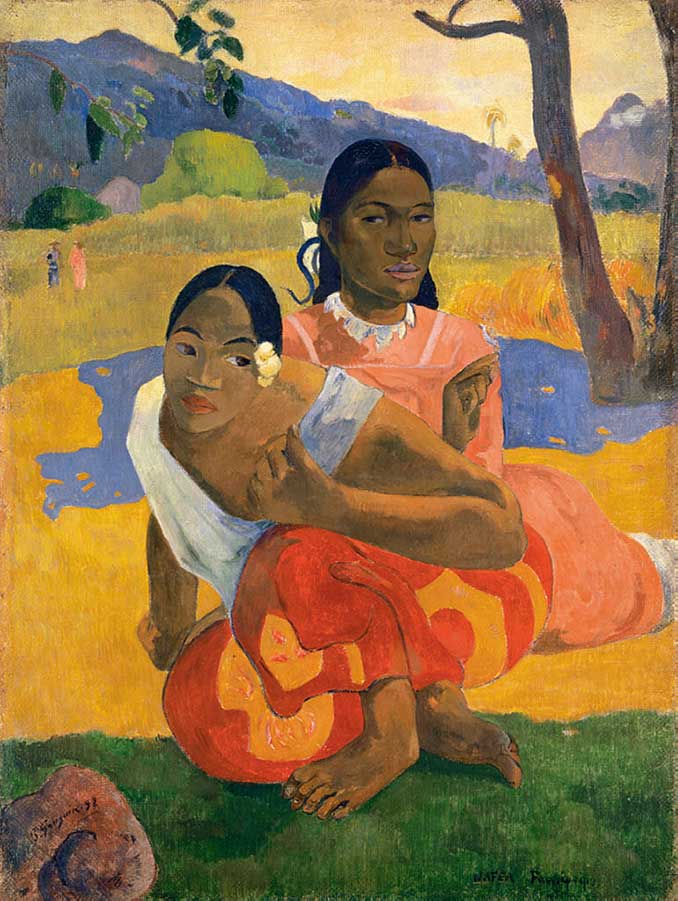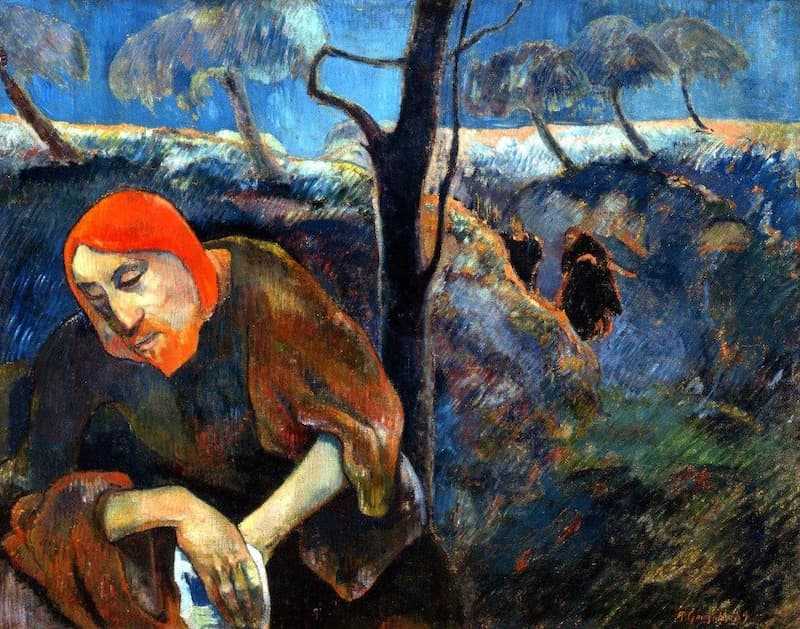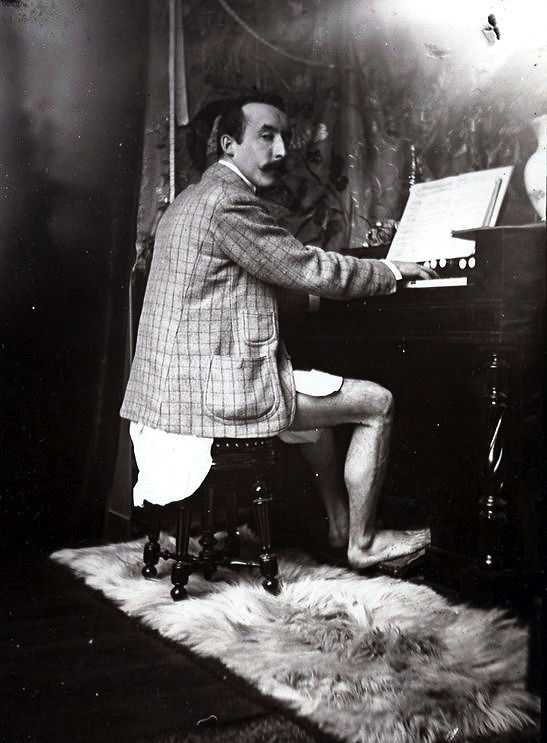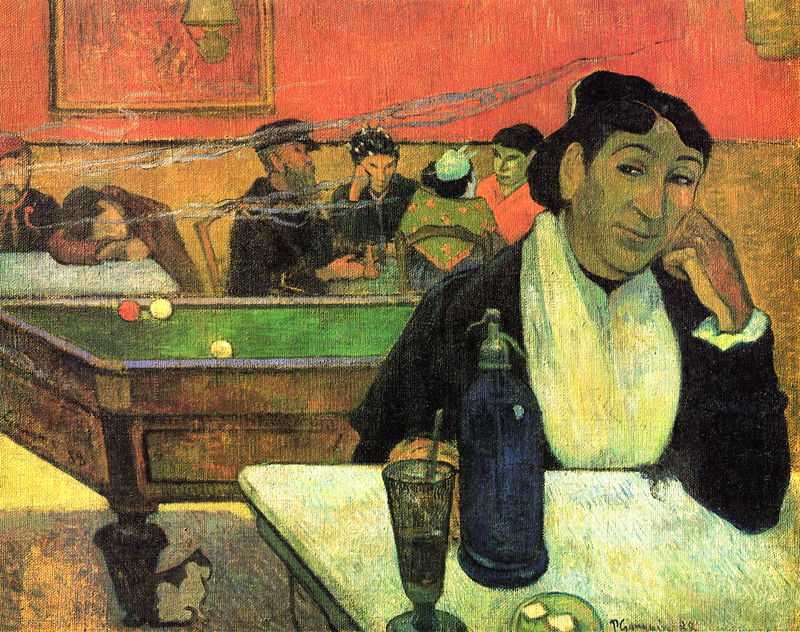1. Early Years
7 June 1848: Eugene Henri Paul Gauguin is born in Paris, the son of Clovis and Aline.
1849: Gauguin and his family emigrate to Peru. This radical move was prompted by Louis-Napoleon coming to power - he was likely to be hostile to Gauguin's father, a liberal newspaper editor. Tragically, Gauguin's father dies on the journey and is hastily buried on the Argentinian coast.

1855: Gauguin and family return to France, to live with Gauguin's Uncle Isadore in Orleans.
1862: Gauguin's family move to Paris, and Gauguin attends a pre-naval college.
1865: Gauguin goes to sea as a ship's boy on a merchant navy ship travelling between Le Havre and Rio de Janeiro.
Interesting fact...
Edouard Manet also worked on a merchant navy ship travelling from Le Havre to Rio de Jainero - he only managed one voyage, between December 1848 and June 1849.
1866: Gauguin starts a 13-month round-the-world voyage as a second lieutenant on a ship called 'Chili'. His mother dies while he is at sea. Her last piece of advice to her son is telling:
"Focus on your career, for you have made yourself very unpopular with my friends."
1868: Gauguin joins the navy and serves as an able-bodied seaman during the 1870/1 Franco-Prussian war.
1871: Gauguin works as a broker's agent at Bertin's in Paris. He meets Claude Emile Shuffenecker, with whom he later studies art at the Louvre, and who becomes a lifelong friend that tolerates Gauguin's many character flaws. Gaugin starts to draw.
22 November 1873: Gauguin marries Mette Sophie Gad, a Danish woman who later worked as a French teacher and translator. As the below picture suggests, Mette had a strong personality - necessary to stand up to Gauguin.
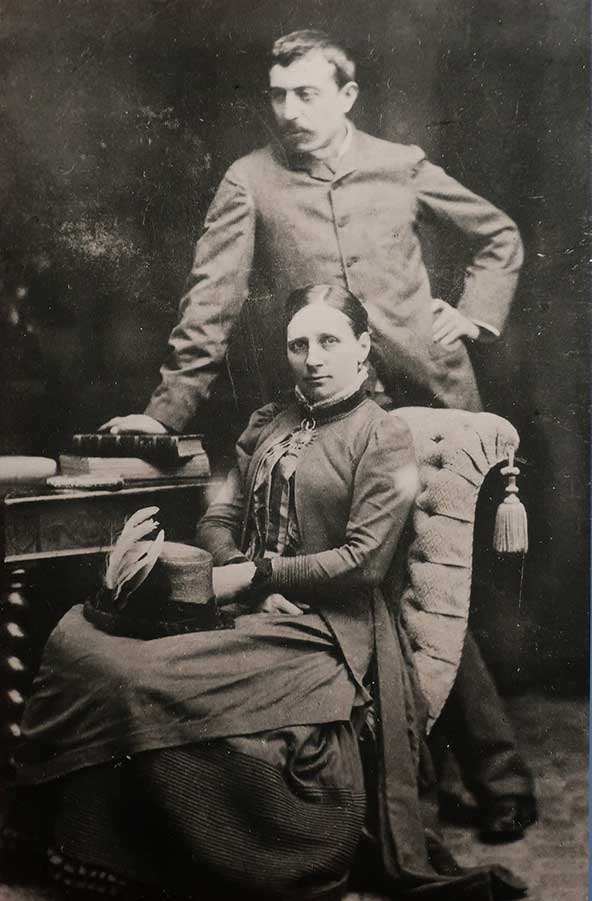
2. Impressionist Years
From 1873: Gauguin's interest in painting starts to take hold. He frequents the cafes at which the impressionists hang out. Initially, he befriends Camille Pissarro and paints with him in Pissarro's garden on Sundays. He is gradually accepted into the impressionist fold, not least because he had money and was happy to buy their works.
1876: Gauguin's first child, Aline, is born. Gauguin has a work accepted to the Salon for the first time.
1879: Gauguin spends the summer painting in Pointoise with Camille Pissarro, and he exhibits at the Fourth Impressionist Exhibition.
1881: Gauguin paints with Pissarro and Paul Cezanne. he also produces Susan Sewing, one of his finest impressionist works. It is well received, although Mette is none too pleased - the model is the family's nanny!
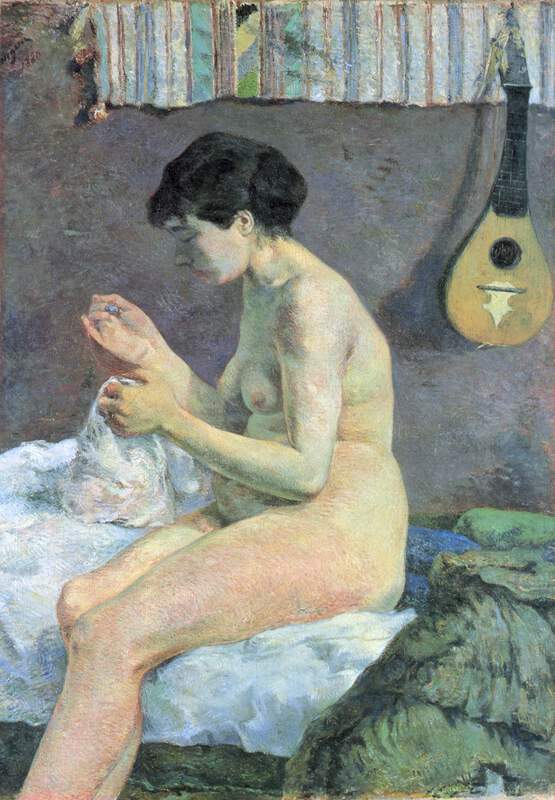
Another important Gauguin work from this period is 'The Little One is Dreaming'.
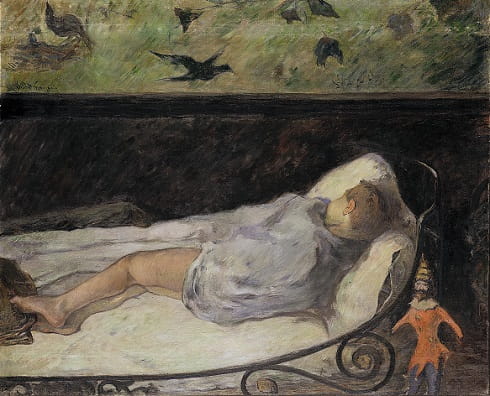
1882: Gauguin exhibits at the Seventh Impressionist Exhibition.
1883: Gauguin quits his well-paid job at the Paris stock exchange and spends the summer painting with Pissarro. His fifth and final child is born.
1884: Gauguin moves his family to Rouen and then, when money gets tight, to live with his in-laws in Copenhagen. He gets a job as a tarpaulin salesman. It wasn't a success: he couldn't speak Danish, and in any event the Danes didn't want French products!
1885: Gauguin's hopes of selling his art in Denmark are dashed when an exhibition in Copenhagen is unsuccessful. He falls out with his in-laws, and moves back to Paris (taking Clovis - his favourite son - with him, but leaving Mette and his other four children).
3. Towards Symbolism
1886: Gauguin works as a bill-poster in Paris. He then puts Clovis in a pension so that he can move to Brittany for the summer to try to establish an artist's colony. He meets Emile Bernard, and the two men work together to develop the Cloisonnist painting style (bold forms separated by dark contours).
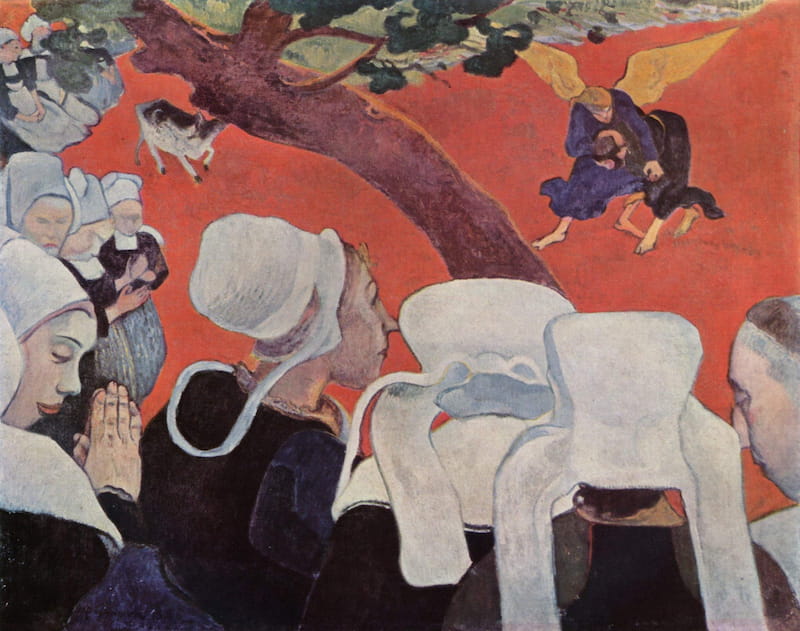
Meanwhile, Gauguin exhibits 19 paintings and a wood carving at the eighth impressionist exhibition. Later in the year, Gauguin's relationship with Pissarro breaks down. Uncharacteristically, Pissarro was later to be rude about Gauguin. For example, he wrote: xxx
Later in the year Gauguin returns to Paris, where he meets Vincent and Theo van Gogh and Edgar Degas. Gauguin's difficulties mean that he starts dreaming of travelling to the tropics - as he did as a young child and in the navy. His dream at this stage was to buy land on Taboga, where he could
"live on fruit and fish for nothing, without anxiety for the day or for the morrow."
1887: Gauguin persuades fellow painter Charles Laval to travel with him to Panama. The trip turns out to be a disaster. Gauguin is forced to work as a labourer, something he hated. As he said in a letter to Mette:
"I have to dig from five thirty in the morning until six in the evening, under the tropical sun and rain. ... At night I am devoured by mosquitos."
Both men also fell ill, eventually making their way to Martinique and then back to France. Gauguin has better luck when he returns to Paris: he moves in with the Schuffeneckers and Theo van Gogh buys some of his pictures and ceramics.
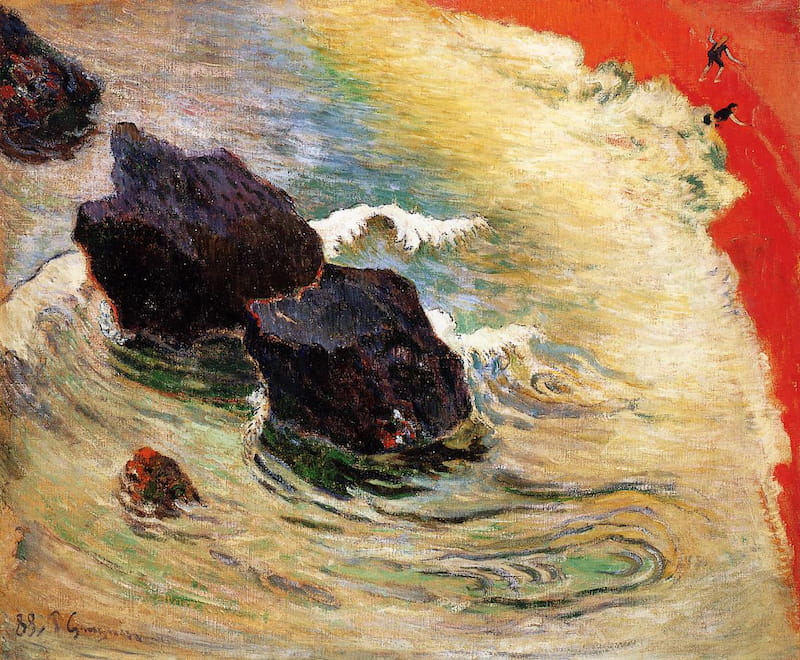
1888: Gauguin travels to Port-Aven in Brittany to paint with Emile Bernard, with whom he starts to paint in a symbolist style. La Vague (The Wave), above, is one of his important works from this stint. Late in the year, Gauguin is persuaded by Theo van Gogh to join Vincent in the Yellow House that he had moved to in Arles in the south of France. The two men produced some fantastic work in the 63 days they were living together, for example their very different takes on Arles Night Cafe (see below). But they also irritated each other, with van Gogh cracking on 23 December 1888 when he sliced off about half of his left ear.
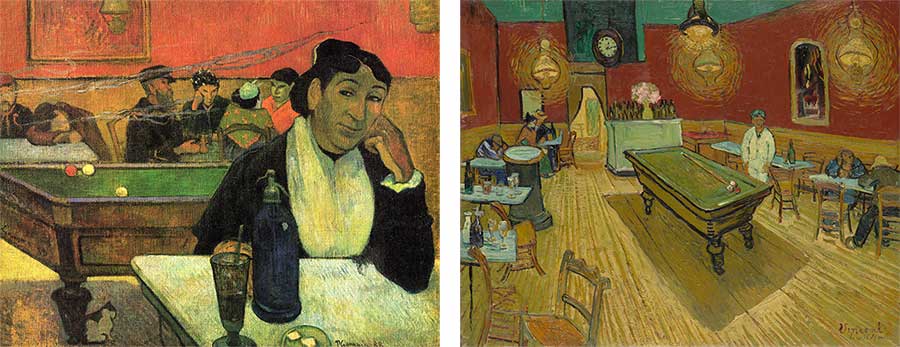
Interesting fact...
Van Gogh often frequented brothels (or, as they were known in France, Maison de Tolerance). After he cut off part of his left ear, he wrapped it in a cloth and took it to his favourite brothel, for a worker called Rachel. He is reported to have said "Keep this carefully, in remembrance of me." It is unclear whether Rachel was a prostitute or a cleaner.
4. Tahiti
4 April 1891: Gauguin sets sail for Tahiti, having managed to sell 30 paintings at the Hotel Druot for 9,860 francs. Gauguin arrives on 28 June, and duly starts work on his autobiography Noa Noa. He spends ten of the next 12 years in the South Seas, producing the artwork for which he is best know. Gauguin infamously 'marries' three child brides over this period (the marriages were arranged, often very hastily). His first 'wife' (remember he was still married to Mette, who was back in France looking after the couple's five children) was to a 13 year-old called Teha'amana (pictured in Spirit of the Dead Watching, below).

1893: Gauguin is lonely, and has eyesight and money problems, forcing him to return to Paris. He leaves his wife and child and was never to see them again (despite returning to Tahiti)! Gauguin shacks up with a woman known as 'Anna the Javanese', painting a nude of her sitting on a chair, and receives an inheritance from his Uncle Isadore. Gauguin uses the money to set up an artist's studio, holding a weekly Salon and dressing in Polynesian costume.
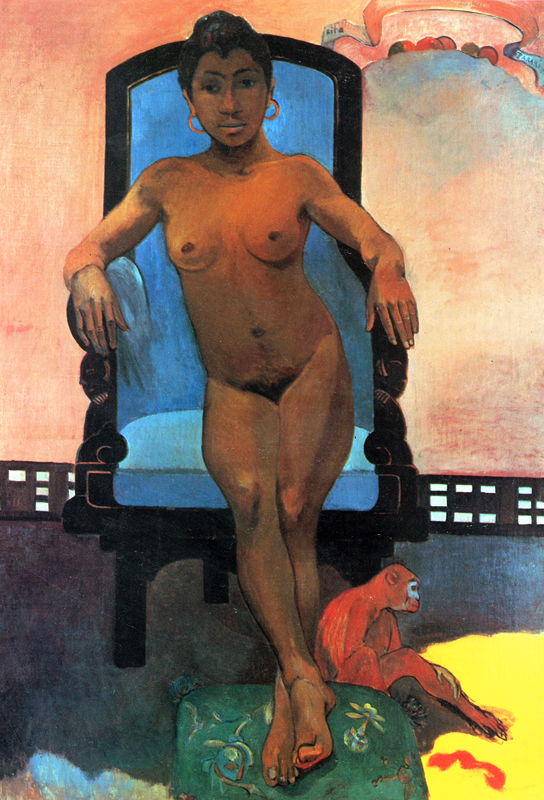
3 April 1895: Gauguin sets sail for Tahiti for a second time. But things were very different from his first trip. He had failed to raise any serious money, and so relied on the charity of friends to arrange a cheap passage for him. His relationship with Mette had irretrievably broken down after he only gave her a small part of his inheritance from Uncle Isadore. And he was never to see Europe again.
1897: Gauguin paints one of his finest masterpieces, Where Do We Come From? Where Are We? Where Are We Going?

1901: Gauguin sells his house in Tahiti and moves to Atuona on the island of Dominique in the Marguesas. Noa Noa is published. The book ends up being a travelogue, but it is criticised for being partly fantasised and partly plagiarised!
1902: Gauguin gets into disputes with the church and the authorities on Atuona. He wants to return to France but ultimately decides against it - because this would destroy the myth of the painter living in a state of nature. This was in large part on the advice of Gauguin's friend George Daniel Monfreid:
"In returning you will risk damaging that process of incubation which is taking place in the public's appreciation of you. At present you are a unique and legendary artist, sending to us from the remote South Seas disconcerting and inimitable works which are the definitive creations of a great man who, in a way, has already gone from this world. ... You should not return. You are already as unassailable as all the great dead; you already belong to the history of art."
8 May 1903: Gauguin dies, at the age of 54, shortly after being sentenced to three months in prison by the authorities (he had been found guilty of libelling a police officer). He is buried at the Calvary Cemetery on Atuona. These days there is a Gauguin Cultural Center in Atuona and the Paul Gaugin Museum, housing a number of important paintings, in Tahiti.
2014: Gauguin's When Will You Marry becomes the world's third most expensive artwork when it is sold for $210 million.
